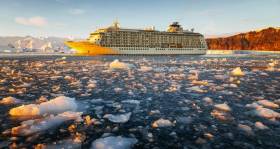Displaying items by tag: Mega Yacht
#BoutiqueYacht – Making a maiden Irish port of call was mega yacht Variety Voyager that brought yesterday a refreshing change in Dublin Port where the trend is for considerably larger giant sized ships, writes Jehan Ashmore.
At just 1,593 gross tonnage the boutique sized cruiseship Variety Voyager with capacity for only 72 guests pampered in ultra-luxury docked next to the Tom Clark Toll-Bridge. The 2012 built sleek four passenger-deck mega yacht had sailed overnight from Holyhead. Notably the call to the north Wales ferryport took place in the inner harbour where the Stena HSS fastferry craft had served Dun Laoghaire but currently only caters for small cruiseships.
The 60 odd nautical mile crossing that is between Holyhead to Dublin takes ferries just over three hours to complete, however the 68m/223ft mega-yacht took a more leisurely eight hour passage. The debut call to Dublin represented the first of seven calls scheduled this season by the boutique mega yacht's upmarket Greek operator Variety Cruises.
Variety Voyager is the largest of the Athens based operator of 11 mega yachts and motor sailers. They are also the largest mega yachts operator in the Mediterranean and one of the top 3 worldwide in the Small Ship market. In 2016-2017, Variety Cruises won in The ‘Best Boutique Cruise Line’ by USA Today Readers’ Choice Awards.
Cruising in one of these small ships offer guests (4 to 5 star luxury) which offerr the ultimate mega-yacht experience. With capacities ranging from 5 to 36 cabins, it is the latter capacity that relates to Variety Voyager whose guests are served by 33 crew.
As one would expect from a mega-yacht, Variety Voyager has cabins and public areas finished with warm fabrics, rich marbles, Axminster carpeting and soft tones wood panelling. Everywhere, unobstructed views of the ocean and of the ports visited.
Asides operating throughout the Mediterranean, Variety Cruises global ports destinations include Cuba and The Seychelles. In addition to the Irish debut, new for 2017 is that the operator have added destinations further into the Atlantic with cruises to Iceland along with southern hemisphere calls to Madagascar and the Mozambique Islands.
Mega Yacht Sets New Record For Most Southerly Navigation
#Offshore - A giant private yacht has broken the record for the most southerly navigation, reaching 78°43.997’ S and 163°41.421’ W at the Bay of Whales in Antarctica’s Ross Sea.
The World, a 43,188-ton yacht with 272 crew and carrying 145 residents and guests, recorded the new polar record – the furthest any vessel has ever sailed – at 10.41 ship’s time (New Zealand time) on Saturday 28 January.
The mega yacht, which circumnavigates the globe every two to three years, is currently undertaking a 22-day expedition of the Ross Sea, including 12 days in Antarctica assisted by EYOS Expeditions led by Rob McCallum.
Commenting on the new record, The World’s Captain Dag H Saevik said: “When we designed this remarkable expedition to the Ross Sea with our residents, that has taken two years of preparation, we hoped that with the right conditions we might be able to reach the ice shelf and set a new record for the most southerly navigation.
“This voyage of more than 5,000 nautical miles has taken us to the most isolated area of the world. Explorers like Amundsen, Shackleton and Scott have always been driven to explore the furthest boundaries. However, not many people get to travel to the end of the earth from their own home.”
Few vessels have made the journey to this remote part of Antarctica. In February last year, the polar expedition vessel Akademik Shokalskiy reported reaching 78°43.971’S.
Mega Yacht 'Skat' Moored on the River Liffey
It's not often we get a mega yacht (a private boat above 70m or 230 feet) in Dublin bay. The Skat is currently lying on Sir John Rogerson’s Quay. Click HERE and have a look at the images at the bottom of the page.
According to Wikipedia The Skat is a luxury yacht built by Lürssen of Bremen, Germany as project 9906, a number prominently displayed on the hull in a font matching that of military vessels. The project started in November 1999 and the yacht launched in 2001. The owner is Charles Simonyi, a former Software Engineer from Microsoft and the fifth space tourist. The yacht is the 64th-largest in the world with a length of 71 metres.































































